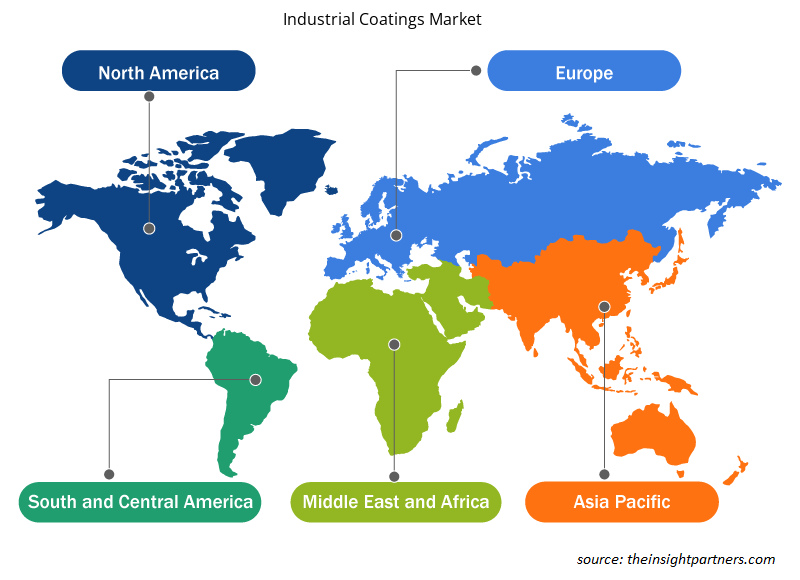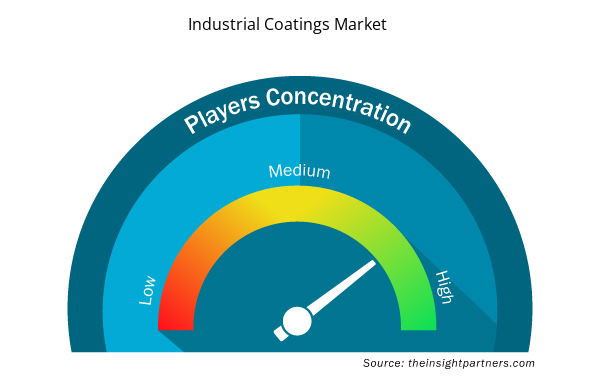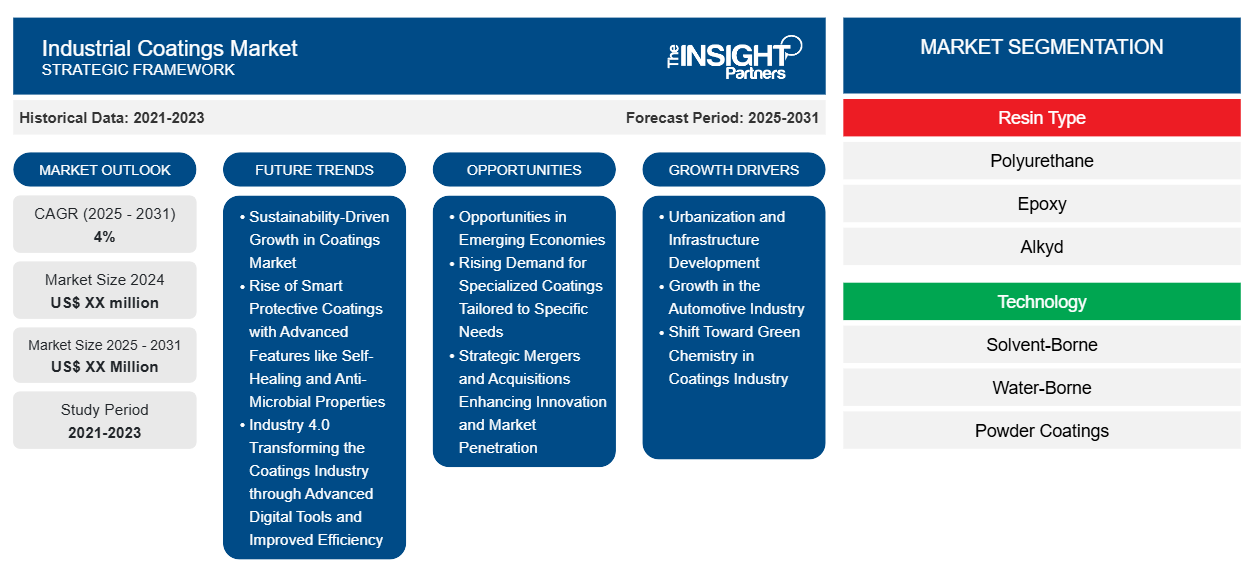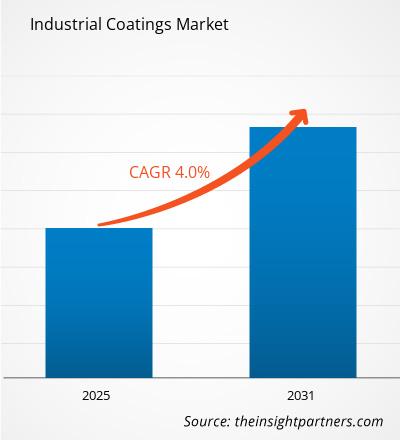Si prevede che il mercato dei rivestimenti industriali registrerà un CAGR del 4% dal 2023 al 2031, con una dimensione di mercato in espansione da XX milioni di dollari USA nel 2023 a XX milioni di dollari USA entro il 2031.
Il report di mercato dei rivestimenti industriali è segmentato in base al tipo di resina (poliuretano, epossidico, alchidico, acrilico, poliestere, fluoropolimeri e altri). Il mercato è segmentato in base alla tecnologia (rivestimenti a base solvente, a base acqua e in polvere). Il mercato è segmentato in base al settore di utilizzo finale (petrolio e gas, automotive, nautica, turbine eoliche, macchinari industriali, aerospaziale, imballaggio e altri). L'analisi globale è ulteriormente suddivisa a livello regionale e nei principali paesi. Le dimensioni del mercato e le previsioni a livello globale, regionale e nazionale per tutti i segmenti di mercato chiave sono coperte nell'ambito. Il report offre il valore in USD per l'analisi, i segmenti, le regioni e i paesi di cui sopra. Il report copre le tendenze di mercato, nonché le dinamiche di mercato come driver, vincoli e opportunità chiave. Il report copre anche il panorama del settore e l'analisi della concorrenza che copre la concentrazione del mercato, l'analisi della mappa di calore, i principali attori e gli sviluppi recenti nel mercato.
Scopo del rapporto
Il report Industrial Coatings Market di The Insight Partners mira a descrivere il panorama attuale e la crescita futura, i principali fattori trainanti, le sfide e le opportunità. Ciò fornirà spunti a vari stakeholder aziendali, come:
- Fornitori/produttori di tecnologia: per comprendere le dinamiche di mercato in evoluzione e conoscere le potenziali opportunità di crescita, consentendo loro di prendere decisioni strategiche informate.
- Investitori: condurre un'analisi completa delle tendenze in merito al tasso di crescita del mercato, alle proiezioni finanziarie del mercato e alle opportunità esistenti lungo la catena del valore.
- Enti di regolamentazione: regolamentano le politiche e le attività di controllo sul mercato allo scopo di ridurre al minimo gli abusi, preservare la fiducia degli investitori e sostenere l'integrità e la stabilità del mercato.
Segmentazione del mercato dei rivestimenti industriali
Tipo di resina
- Poliuretano
- Epossidico
- Alchidico
- Acrilico
- Poliestere
- Fluoropolimeri
Tecnologia
- A base di solvente
- Trasmesso dall'acqua
- Rivestimenti in polvere
Settore di utilizzo finale
- Petrolio e gas
- Automobilistico
- Marino
- Turbina eolica
- Macchinari industriali
- Aerospaziale
- Confezione
Geografia
- America del Nord
- Europa
- Asia-Pacifico
- America del Sud e Centro
- Medio Oriente e Africa
Geografia
- America del Nord
- Europa
- Asia-Pacifico
- America del Sud e Centro
- Medio Oriente e Africa
Personalizza questo report in base alle tue esigenze
Riceverai la personalizzazione gratuita di qualsiasi report, comprese parti di questo report, o analisi a livello nazionale, pacchetto dati Excel, oltre a usufruire di grandi offerte e sconti per start-up e università
- Scopri le principali tendenze di mercato in questo rapporto.Questo campione GRATUITO includerà analisi di dati che spaziano dalle tendenze di mercato alle stime e alle previsioni.
Driver di crescita del mercato dei rivestimenti industriali
- Urbanizzazione e sviluppo delle infrastrutture: il ritmo rapido dell'urbanizzazione, insieme all'aumento dei finanziamenti governativi per lo sviluppo delle infrastrutture, in particolare la costruzione di ponti, autostrade e ferrovie, crea una crescente necessità di vernici industriali di lunga durata. Tali rivestimenti agiscono come protezione contro la corrosione e i danni fisici, aumentando così la longevità delle strutture.
- Crescita nel settore automobilistico: la crescita del settore automobilistico è stata un fattore importante che ha favorito la domanda di rivestimenti industriali. Con le tendenze in evoluzione verso un peso inferiore e un aspetto migliore, i produttori hanno incorporato nuove tecnologie che consentono applicazioni di rivestimenti protettivi con maggiore efficienza e rispetto dell'ambiente.
- Spostamento verso la chimica verde nel settore dei rivestimenti: nel recente passato, il settore dei rivestimenti è stato orientato verso la chimica verde dalle severe normative e dalla crescente preferenza dei consumatori per prodotti ecocompatibili. In questo caso, l'attenzione si è concentrata sui bassi livelli di COV (composti organici volatili) e sui rivestimenti a base d'acqua, poiché la maggior parte delle aziende cerca di rispettare le normative senza danneggiare l'ambiente.
Tendenze future del mercato dei rivestimenti industriali
- Crescita guidata dalla sostenibilità nel mercato dei rivestimenti: si prevede che il movimento verso la sostenibilità guiderà il mercato. Si prevede che una crescita considerevole nell'innovazione dei rivestimenti formulati da materiali di origine biologica o riciclati sarà vista come mirata a consumatori e settori attenti all'ambiente che vogliono ridurre la propria impronta di carbonio.
- Ascesa di rivestimenti protettivi intelligenti con caratteristiche avanzate come proprietà auto-riparanti e antimicrobiche: c'è una tendenza crescente nella produzione di rivestimenti protettivi intelligenti che hanno la capacità di auto-ripararsi, cambiare colore o fornire proprietà antimicrobiche. Tali rivestimenti impiegano la nanotecnologia e altri materiali avanzati come mezzo per soddisfare i loro obiettivi e quindi sono molto richiesti a causa dei loro molteplici utilizzi, come nei settori medico ed edile.
- Industria 4.0 Trasformazione del settore dei rivestimenti tramite strumenti digitali avanzati e maggiore efficienza: l'adozione delle tecnologie dell'Industria 4.0 sta consentendo cambiamenti nel settore dei rivestimenti. L'uso di strumenti digitali avanzati per il monitoraggio e il controllo delle applicazioni, la manutenzione predittiva e l'analisi dei dati porterà a sua volta a livelli più elevati di efficienza, meno sprechi e una migliore qualità del prodotto.
Opportunità di mercato dei rivestimenti industriali
- Opportunità nelle economie emergenti: la rapida industrializzazione nelle economie emergenti presenta significative opportunità di crescita. Aree come Asia-Pacifico, America Latina e Africa stanno sperimentando un appetito per i rivestimenti industriali dovuto alla crescita delle infrastrutture e della produzione in queste regioni.
- Domanda crescente di rivestimenti specializzati su misura per esigenze specifiche: l'uso di rivestimenti progettati specificamente per determinati usi è in aumento, ad esempio rivestimenti anticorrosivi, rivestimenti resistenti al calore e rivestimenti puramente decorativi. Un'azienda può anche puntare su alcune parti del mercato creando caratteristiche differenzianti per i prodotti già progettati.
- Fusioni e acquisizioni strategiche che potenziano l'innovazione e la penetrazione del mercato: la presenza sul mercato e la tecnologia potrebbero essere migliorate tramite un uso ottimale di fusioni e acquisizioni. La cooperazione con aziende tecnologiche o produttori incoraggia le aziende a essere più innovative, a migliorare i loro prodotti e a penetrare nuovi mercati.
Approfondimenti regionali sul mercato dei rivestimenti industriali
Le tendenze regionali e i fattori che influenzano il mercato dei rivestimenti industriali durante il periodo di previsione sono stati ampiamente spiegati dagli analisti di Insight Partners. Questa sezione discute anche i segmenti e la geografia del mercato dei rivestimenti industriali in Nord America, Europa, Asia Pacifico, Medio Oriente e Africa e America meridionale e centrale.

- Ottieni i dati specifici regionali per il mercato dei rivestimenti industriali
Ambito del rapporto sul mercato dei rivestimenti industriali
| Attributo del report | Dettagli |
|---|---|
| Dimensioni del mercato nel 2023 | XX milioni di dollari USA |
| Dimensioni del mercato entro il 2031 | XX milioni di dollari USA |
| CAGR globale (2023-2031) | 4% |
| Dati storici | 2021-2022 |
| Periodo di previsione | 2024-2031 |
| Segmenti coperti | Per tipo di resina
|
| Regioni e Paesi coperti | America del Nord
|
| Leader di mercato e profili aziendali chiave |
|
Densità degli attori del mercato dei rivestimenti industriali: comprendere il suo impatto sulle dinamiche aziendali
Il mercato dei rivestimenti industriali sta crescendo rapidamente, spinto dalla crescente domanda degli utenti finali dovuta a fattori quali l'evoluzione delle preferenze dei consumatori, i progressi tecnologici e una maggiore consapevolezza dei vantaggi del prodotto. Con l'aumento della domanda, le aziende stanno ampliando le loro offerte, innovando per soddisfare le esigenze dei consumatori e capitalizzando sulle tendenze emergenti, il che alimenta ulteriormente la crescita del mercato.
La densità degli operatori di mercato si riferisce alla distribuzione di aziende o società che operano in un particolare mercato o settore. Indica quanti concorrenti (operatori di mercato) sono presenti in un dato spazio di mercato in relazione alle sue dimensioni o al valore di mercato totale.
Le principali aziende che operano nel mercato dei rivestimenti industriali sono:
- Akzo Nobel NV
- Pitture asiatiche
- Sistemi di rivestimento Axalta, LLC
- BASF SE
- Azienda
Disclaimer : le aziende elencate sopra non sono classificate secondo un ordine particolare.

- Ottieni una panoramica dei principali attori del mercato dei rivestimenti industriali
Punti chiave di vendita
- Copertura completa: il rapporto esamina in modo completo i prodotti, i servizi, le tipologie e gli utenti finali del mercato dei rivestimenti industriali, offrendo una panoramica olistica.
- Analisi degli esperti: il rapporto è compilato sulla base della conoscenza approfondita di esperti e analisti del settore.
- Informazioni aggiornate: il rapporto garantisce la pertinenza aziendale grazie alla copertura di informazioni recenti e tendenze nei dati.
- Opzioni di personalizzazione: questo report può essere personalizzato per soddisfare le esigenze specifiche del cliente e adattarsi in modo appropriato alle strategie aziendali.
Il rapporto di ricerca sul mercato dei rivestimenti industriali può, quindi, aiutare a guidare il percorso di decodificazione e comprensione dello scenario del settore e delle prospettive di crescita. Sebbene possano esserci alcune preoccupazioni valide, i vantaggi complessivi di questo rapporto tendono a superare gli svantaggi.
- Analisi storica (2 anni), anno base, previsione (7 anni) con CAGR
- Analisi PEST e SWOT
- Valore/volume delle dimensioni del mercato - Globale, regionale, nazionale
- Industria e panorama competitivo
- Set di dati Excel


- Transdermal Drug Delivery System Market
- Wheat Protein Market
- Advanced Planning and Scheduling Software Market
- Artificial Intelligence in Healthcare Diagnosis Market
- Drain Cleaning Equipment Market
- Underwater Connector Market
- Smart Parking Market
- Europe Industrial Chillers Market
- Arterial Blood Gas Kits Market
- Hummus Market

Report Coverage
Revenue forecast, Company Analysis, Industry landscape, Growth factors, and Trends

Segment Covered
This text is related
to segments covered.

Regional Scope
North America, Europe, Asia Pacific, Middle East & Africa, South & Central America

Country Scope
This text is related
to country scope.
Domande frequenti
The development of sustainable coatings is expected to be the key market trends.
Based on geography, Asia Pacific held the largest share of the industrial coatings market due to its growing automotive, packaging, and wind turbine industry.
Based on end-use industry, the wind turbine segment is expected to witness the fastest growth during the forecast period.
The strong growth of the industrial sector across the globe is driving the market growth.
Hempel A/S, Nippon Paint Holdings, Jamestown Coating Technologies, The Sherwin-Williams Company, PPG Industries Inc., Kansai Paint Co.Ltd., ArcelorMittal, Mankiewicz Hamburg, Akzo Nobel N.V., and Baril Coatings USA are the key players operating in the industrial coatings market.
The Industrial Coatings Market is estimated to witness a CAGR of 4% from 2023 to 2031
Trends and growth analysis reports related to Chemicals and Materials : READ MORE..
The List of Companies
- Akzo Nobel N.V.
- Asian Paints
- Axalta Coating Systems, LLC
- BASF SE
- Hempel A/S
- Jotun
- Kansai Paint Co., Ltd.
- Nippon Paint Holdings Co., Ltd.
- PPG Industries, Inc.
- The Sherwin-Williams Company
The Insight Partners performs research in 4 major stages: Data Collection & Secondary Research, Primary Research, Data Analysis and Data Triangulation & Final Review.
- Data Collection and Secondary Research:
As a market research and consulting firm operating from a decade, we have published and advised several client across the globe. First step for any study will start with an assessment of currently available data and insights from existing reports. Further, historical and current market information is collected from Investor Presentations, Annual Reports, SEC Filings, etc., and other information related to company’s performance and market positioning are gathered from Paid Databases (Factiva, Hoovers, and Reuters) and various other publications available in public domain.
Several associations trade associates, technical forums, institutes, societies and organization are accessed to gain technical as well as market related insights through their publications such as research papers, blogs and press releases related to the studies are referred to get cues about the market. Further, white papers, journals, magazines, and other news articles published in last 3 years are scrutinized and analyzed to understand the current market trends.
- Primary Research:
The primarily interview analysis comprise of data obtained from industry participants interview and answers to survey questions gathered by in-house primary team.
For primary research, interviews are conducted with industry experts/CEOs/Marketing Managers/VPs/Subject Matter Experts from both demand and supply side to get a 360-degree view of the market. The primary team conducts several interviews based on the complexity of the markets to understand the various market trends and dynamics which makes research more credible and precise.
A typical research interview fulfils the following functions:
- Provides first-hand information on the market size, market trends, growth trends, competitive landscape, and outlook
- Validates and strengthens in-house secondary research findings
- Develops the analysis team’s expertise and market understanding
Primary research involves email interactions and telephone interviews for each market, category, segment, and sub-segment across geographies. The participants who typically take part in such a process include, but are not limited to:
- Industry participants: VPs, business development managers, market intelligence managers and national sales managers
- Outside experts: Valuation experts, research analysts and key opinion leaders specializing in the electronics and semiconductor industry.
Below is the breakup of our primary respondents by company, designation, and region:

Once we receive the confirmation from primary research sources or primary respondents, we finalize the base year market estimation and forecast the data as per the macroeconomic and microeconomic factors assessed during data collection.
- Data Analysis:
Once data is validated through both secondary as well as primary respondents, we finalize the market estimations by hypothesis formulation and factor analysis at regional and country level.
- Macro-Economic Factor Analysis:
We analyse macroeconomic indicators such the gross domestic product (GDP), increase in the demand for goods and services across industries, technological advancement, regional economic growth, governmental policies, the influence of COVID-19, PEST analysis, and other aspects. This analysis aids in setting benchmarks for various nations/regions and approximating market splits. Additionally, the general trend of the aforementioned components aid in determining the market's development possibilities.
- Country Level Data:
Various factors that are especially aligned to the country are taken into account to determine the market size for a certain area and country, including the presence of vendors, such as headquarters and offices, the country's GDP, demand patterns, and industry growth. To comprehend the market dynamics for the nation, a number of growth variables, inhibitors, application areas, and current market trends are researched. The aforementioned elements aid in determining the country's overall market's growth potential.
- Company Profile:
The “Table of Contents” is formulated by listing and analyzing more than 25 - 30 companies operating in the market ecosystem across geographies. However, we profile only 10 companies as a standard practice in our syndicate reports. These 10 companies comprise leading, emerging, and regional players. Nonetheless, our analysis is not restricted to the 10 listed companies, we also analyze other companies present in the market to develop a holistic view and understand the prevailing trends. The “Company Profiles” section in the report covers key facts, business description, products & services, financial information, SWOT analysis, and key developments. The financial information presented is extracted from the annual reports and official documents of the publicly listed companies. Upon collecting the information for the sections of respective companies, we verify them via various primary sources and then compile the data in respective company profiles. The company level information helps us in deriving the base number as well as in forecasting the market size.
- Developing Base Number:
Aggregation of sales statistics (2020-2022) and macro-economic factor, and other secondary and primary research insights are utilized to arrive at base number and related market shares for 2022. The data gaps are identified in this step and relevant market data is analyzed, collected from paid primary interviews or databases. On finalizing the base year market size, forecasts are developed on the basis of macro-economic, industry and market growth factors and company level analysis.
- Data Triangulation and Final Review:
The market findings and base year market size calculations are validated from supply as well as demand side. Demand side validations are based on macro-economic factor analysis and benchmarks for respective regions and countries. In case of supply side validations, revenues of major companies are estimated (in case not available) based on industry benchmark, approximate number of employees, product portfolio, and primary interviews revenues are gathered. Further revenue from target product/service segment is assessed to avoid overshooting of market statistics. In case of heavy deviations between supply and demand side values, all thes steps are repeated to achieve synchronization.
We follow an iterative model, wherein we share our research findings with Subject Matter Experts (SME’s) and Key Opinion Leaders (KOLs) until consensus view of the market is not formulated – this model negates any drastic deviation in the opinions of experts. Only validated and universally acceptable research findings are quoted in our reports.
We have important check points that we use to validate our research findings – which we call – data triangulation, where we validate the information, we generate from secondary sources with primary interviews and then we re-validate with our internal data bases and Subject matter experts. This comprehensive model enables us to deliver high quality, reliable data in shortest possible time.


 Ottieni un campione gratuito per questo repot
Ottieni un campione gratuito per questo repot